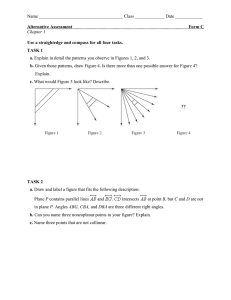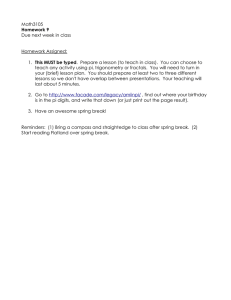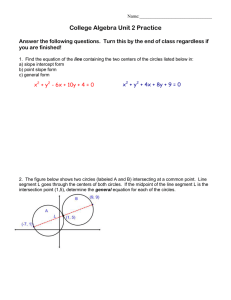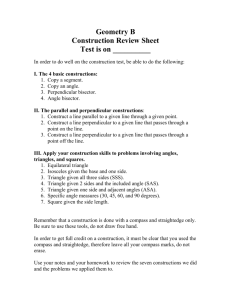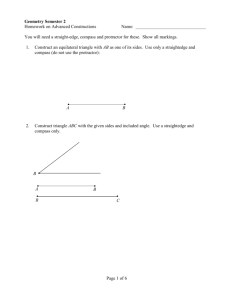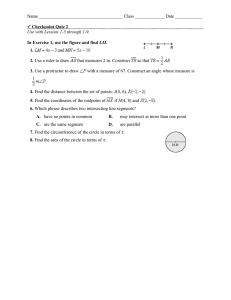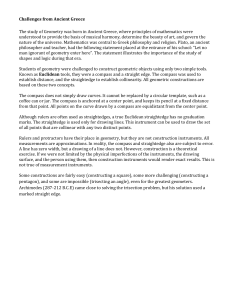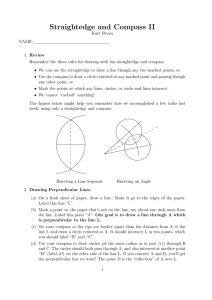Straightedge and Compass
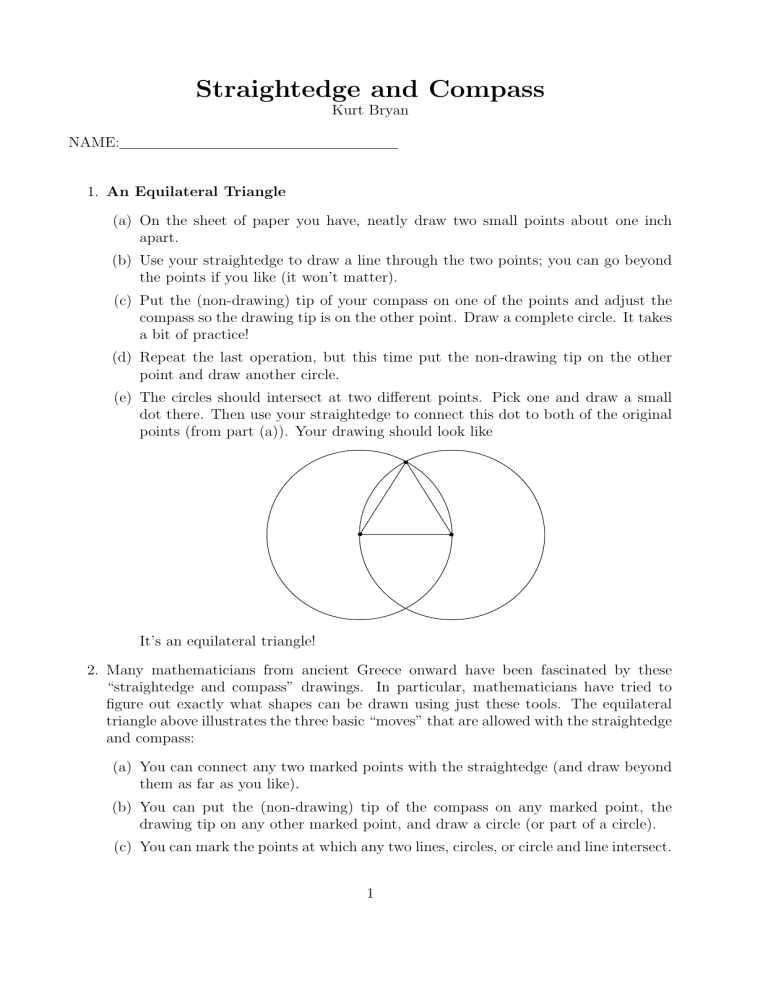
Straightedge and Compass
Kurt Bryan
NAME:
1.
An Equilateral Triangle
(a) On the sheet of paper you have, neatly draw two small points about one inch apart.
(b) Use your straightedge to draw a line through the two points; you can go beyond the points if you like (it won’t matter).
(c) Put the (non-drawing) tip of your compass on one of the points and adjust the compass so the drawing tip is on the other point. Draw a complete circle. It takes a bit of practice!
(d) Repeat the last operation, but this time put the non-drawing tip on the other point and draw another circle.
(e) The circles should intersect at two different points. Pick one and draw a small dot there. Then use your straightedge to connect this dot to both of the original points (from part (a)). Your drawing should look like
It’s an equilateral triangle!
2. Many mathematicians from ancient Greece onward have been fascinated by these
“straightedge and compass” drawings. In particular, mathematicians have tried to figure out exactly what shapes can be drawn using just these tools. The equilateral triangle above illustrates the three basic “moves” that are allowed with the straightedge and compass:
(a) You can connect any two marked points with the straightedge (and draw beyond them as far as you like).
(b) You can put the (non-drawing) tip of the compass on any marked point, the drawing tip on any other marked point, and draw a circle (or part of a circle).
(c) You can mark the points at which any two lines, circles, or circle and line intersect.
1
The straightedge may NOT be used as a ruler—no marks are allowed on it!
3.
Bisecting a Line Segment
On your drawing of the equilateral triangle, connect the two points where the circles intersect. The resulting line segment bisects (divides in two) the first line segment you drew!
The two intersecting lines also form a right angle .
4.
Bisecting an Angle
(a) On a fresh sheet of paper, mark a point; I’ll call this point “A”—you can even write a small “A” next to it. Then draw two lines through A; make them pretty long.
(b) The two lines form an “acute” angle with vertex at the point A. Our goal is to bisect this angle, EXACTLY. No eyeballing allowed!
(c) Use your compass to draw a circle centered at A (any radius you like, but not too big or small).
(d) Your circle should intersect each line through A. Mark each of these points; label one “B” and the other “C”.
(e) Draw a circle (any radius) centered at B. Draw a circle of the same radius through
C.
(f) Mark one (or both) of the points where the circles from part (e) intersect. Now look at the point A—do you see how to bisect the original angle?
5.
Drawing Perpendicular Lines
(a) On a fresh sheet of paper, draw a line. Make it go to the edges of the paper.
(b) Mark a point on the paper that’s not on the line, say about one inch away from the line. Let’s call this point “A”. Our goal is to draw a line through A which is perpendicular to the line in part (a).
(c) Set your compass so the tips are farther apart than the distance from A to the line and draw a circle centered at A. It should intersect the line in two points, which we’ll call “B” and “C”.
(d) Use your compass to draw circles (of the same radius as in part (c)) through B and C. The circles should both pass through A, and also intersect at another point “D” on the other side of the line. If you connect A and D, you’ll get the perpendicular line we want! The point D is the “reflection” of A over the line.
6.
Drawing a Square Can you figure out how to put some of the ideas above to work to draw a perfect square? Start with two points on a fresh sheet of paper, connect them with a line segment. Can you construct a square which has this line segment as one of its sides?
7. Further ideas: arbitrary triangle, draw all angle bisectors. Draw hexagon, pentagon.
Divide a line segment into thirds, etc. Construct a 45 degree angle.
2
